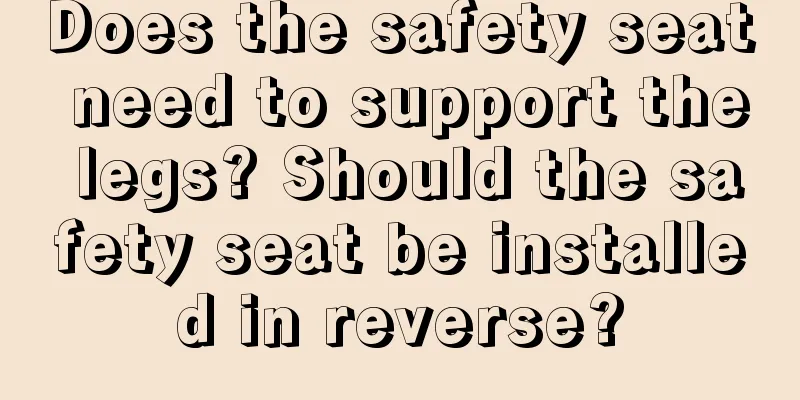Does the safety seat need to support the legs? Should the safety seat be installed in reverse?

|
Safety seats are very common in insomnia, and parents who have installed safety seats know that there is an accessory called support legs, so here we need to understand whether safety seats need support legs? Should safety seats be installed in reverse? Should the safety seat support the legs?Yes. If the safety seat does not have an anti-rollover device, the rollover will greatly increase the damage to the child in a collision. The typical anti-rollover devices are support legs and upper pull straps. The support legs are more suitable for seats in the 0-4 year old group, and the upper pull straps are more suitable for seats from 9 months to 12 years old. Take the support leg as an example. It is a support rod extending to the bottom of the car in front of the safety seat, which can be retracted and adjusted in height to adapt to different models. The biggest role of the support leg is to prevent the safety seat from flipping, making the seat more solid, reducing the forward displacement during a collision, thereby increasing safety, so it is still necessary to install support legs on the safety seat. In addition, after the three-child policy came out some time ago, some parents may think that the current baby uses the safety seat used by the older brother and sister. Or in some families with older children, parents may think that it will not take long, so they will choose to buy a second-hand safety seat. But when buying items, we will check whether the shelf life on it has expired, and safety seats are no exception. Should the safety seat be installed in reverse?Not all child safety seats need to be installed in reverse. Reverse installation of safety seats can increase the force bearing area. If a collision occurs, the child's back and head will collide with the seat. Due to the larger force bearing area, the force on each part will be reduced. The damage will be minimized. If it is installed in the forward direction, the child's neck and head are easily injured due to inertia, but when it is installed in the reverse direction, the child's head is always against the back of the seat due to inertia. Newborns can significantly reduce the damage in accidents by using reverse installation child safety seats. Unlike adults, babies' heads are large and heavy relative to their bodies. The weight of their heads is about 25% of their total weight, while the weight of adults' heads is only 6% of their total body weight. Babies cannot withstand huge impact forces like adults when their neck and spinal muscles are not fully developed. They need special protection in collisions. In the event of a collision, in a forward installation safety seat, the child will rush forward and be subject to the reaction force of the 5-point seat belt. The force points will be concentrated on 2 points on the shoulders, 2 points on the hips and 1 point on the crotch. The fragile cervical spine of infants and young children will be subject to a lot of pulling force, which is very dangerous. How old should a safety seat be?Children under 12 years old and under 150 cm in height must be safely placed in a properly approved child protection device. Generally, it is used until the child is 12 years old. At present, the international definition of safety seats is not based on the age of the child, but the most standard is based on the weight of the child. Therefore, babies weighing less than 36 kg generally need to use safety seats. Safety seats are designed for children of different weights (or age groups) and installed in cars to effectively improve the safety of children riding in cars. The definition of the European mandatory implementation standard ECE R44/03 is: a child safety protection system composed of a seat belt assembly or flexible components, adjustment mechanisms, accessories, etc. with an ISOFIX interface that can be fixed to a motor vehicle. In the event of a car collision or sudden deceleration, it can reduce the impact force on children and restrict the movement of children's bodies, thereby reducing their injuries. Should I buy a 360-degree rotating safety seat?It is better to have a child safety seat that rotates 360 degrees. Because in terms of safety performance, the 360-degree rotating car child safety seat is currently the safest car child safety seat. It can greatly reduce the impact of car safety accidents on children and is the best way to protect children. It is recommended that parents install a car child safety seat in the back seat of a private car when the child is 0-4 years old. In this way, parents do not have to worry too much about the safety of their children while driving. It is also important to note that all 360-degree swivel seats are equipped with front supports, and some are also equipped with rear supports. In addition, the size and weight of the swivel seat are larger than similar products. |
<<: Does Shanghai sulfur soap remove mites? Is Shanghai sulfur soap good for washing your face?
>>: Are safety seats universal? Are safety seats required by law?
Recommend
Does painless childbirth have any effect on the baby? Does painless childbirth have any side effects?
Many people must have heard of painless childbirt...
How to make your baby develop a habit of drinking water? What are the functions of a children's smart water cup?
Drinking water for babies has always been a heada...
Can pregnant women eat Gorgon fruit cake? Be careful not to eat too much
Pregnant women can eat Gorgon fruit cake. Gorgon ...
How many bowel movements are normal for babies?
The baby's eating, drinking, defecating and u...
Can I eat cauliflower during breastfeeding? Will eating cauliflower during breastfeeding have any effect on the baby?
We often say that mother's food is baby's...
How to get your baby to speak as early as possible
The language development progress of each infant ...
Can I sleep on a cool mat during the dog days of summer? Can I sleep on a cool mat during the summer?
China has always attached great importance to nur...
Can Omo sterilizing liquid be used to wash underwear? Can Omo sterilizing liquid be used together with laundry detergent?
Compared with disinfectant, sterilizing liquid is...
When do children's deciduous teeth fall out? When will permanent teeth grow in?
For children, the period of tooth replacement is ...
What kind of exercise should I do for postpartum urinary incontinence? Do I need to repair my pelvic floor muscles for postpartum urinary incontinence?
Postpartum urinary incontinence is very common in...
Ofmom infant formula liquid milk powder eliminates the tedious brewing process and is a wise choice for new parents
After having a baby, new parents need to learn ho...
How old can babies eat steak?
Children over two years old can eat steak. Steak ...
What should parents do if their children are addicted to iPad?
I believe that today, there are not many parents ...
What is the reason for frequent spitting up of babies? What should I do if my baby frequently spits up?
Usually, babies who have just been born need to d...
Can stretch marks be prevented? The effect is not very good
Can stretch marks be prevented? Of course they ca...









